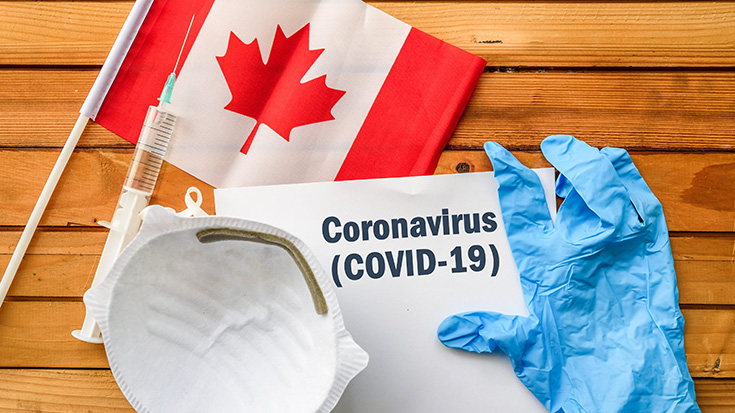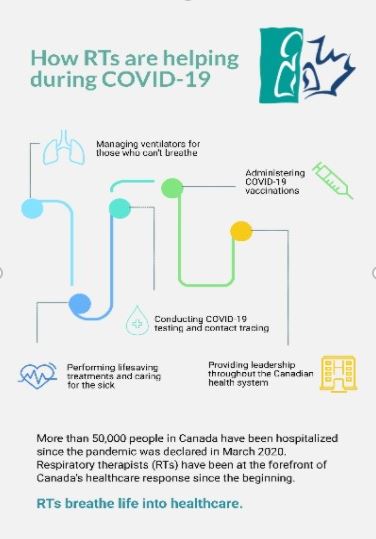
The past 18 months continue to be a hectic period for respiratory therapists (RTs) in Canada who have been providing essential care for those affected by COVID-19. Canadian RTs have been a critical part of the front lines of Canada’s health care response to the pandemic. At no point in memorable history have RTs been more in the national spotlight in Canada.
As the voice for Canada’s community of RTs, the Canadian Society of Respiratory Therapists (CSRT) has a mandate to advance the profession of respiratory therapy (RT). The association achieves this by providing practice supports and continuing professional development for members, advocating for RTs and their patients, and fostering the growth of the evidence basis of the profession. The COVID-19 pandemic established itself as a period of unprecedented challenge for the RT profession. The CSRT has been proud to support RTs and provide national leadership on issues concerning respiratory care.
A Snapshot of COVID-19 in Canada
The first wave of COVID-19 infections in Canada began in January 2020 and lasted close to five months. Larger second and third waves followed, and first started occurring across the country in September 2020. As has been witnessed in many other parts of the world, Canada is now experiencing the early days of a fourth wave that is expected to bring unique challenges compared to those of earlier waves.
Health care in Canada is governed and managed by each of its 10 provinces and three territories. At the same time, funding mechanisms are often seen as a responsibility of the federal level of government. As a result, tensions between governments relating to health care usually exist. However, the variation between the health care approaches taken in each jurisdiction became evident throughout the pandemic. During COVID-19, more than at any other time, RTs and their practices were directly impacted by these tensions. For example, particularly during the first wave of the pandemic, access to N95 masks for RTs performing pulmonary function testing or entering the room of ventilated COVID-19 patients was not guaranteed in all jurisdictions and depended upon a patchwork of local guidelines.
A similar situation occurred concerning public health regulation and guidance across the country. The Public Health Agency of Canada gives guidance at a national level; however, the provincial and territorial ministries of health and their public health branches governed all aspects of the local response. As a result, public health guidance varied between jurisdictions. Compounded by the fact that direction evolved as the understanding of the pandemic grew, this likely contributed to confusion concerning safe practices.
The RT Experience
The third wave of COVID-19, in particular, threatened to overwhelm the capacity of acute care hospitals, particularly intensive care units (ICUs) in several of Canada’s most populous provinces.1 Concern over the impact of COVID-19 on hospital capacity, and ICU capacity, in particular, prompted governments across the country to implement highly restrictive public health regulations, including school closures, curfews, and forbidding public gatherings. Previously, Canada did not experience the high rates of infection that occurred in many other countries during the first wave. Unfortunately, by the third wave, the infection rates in two provinces (Alberta and Manitoba) had reached the highest per capita levels of any state or province in North America.
Many people worldwide had their lives interrupted in unimaginable ways, and most were experiencing anything but a ‘normal work day’ at any given point. To say that this was the case for respiratory therapists would be an understatement. While RTs in Canada have a vast scope of practice and work in many different areas of health care (e.g., critical care, community care, and primary care), many were asked to take on roles and responsibilities they wouldn’t typically undertake.2 In areas with lower caseload and critical care needs, some RTs took on roles for which they were prepared but were atypical for them in a regular workday (e.g., contact tracing for public health agencies and administering vaccinations). However, in most locations, RTs are at the forefront of critical care and managing the overwhelming number of ventilated and critically ill patients. In many cases, RTs stepped into critical care roles from their usual practice settings or returned to practice from retirement.
 CSRT Infographic used to help inform the public of the role of the respiratory therapist.
CSRT Infographic used to help inform the public of the role of the respiratory therapist.Administration of the first COVID-19 vaccine approved for use in Canada began in December 2020. Since that time, Canada has achieved high rates of vaccination. Specifically, 72.5% of the total population have received one vaccine dose, and 65.49% are now fully vaccinated (as of August 21, 2021).3 Canada’s vaccination rates will undoubtedly play a role in the impact felt by RTs through the fourth wave of the pandemic.
Given the variation between jurisdictions, the impact of COVID-19, and the public health measures implemented by governments, RTs across Canada have been impacted by the pandemic in different ways depending upon where they live and work. The uncertainty associated with the magnitude and impact of the impending fourth wave and persistent vaccine hesitancy amongst some proportion of the population remain top concerns of Canadian RTs. As is likely the experience of those in other countries providing respiratory care on the front lines, Canadian RTs are demonstrating tremendous resiliency in the face of a protracted period of substantial physical, mental, and emotional stress. The uncertainly associated with the impacts of mass vaccination and emerging COVID-19 variants on the fourth wave of the pandemic further compounds these experiences. The effects of the grueling call to action on respiratory therapists remain a top concern of the CSRT.
The CSRT Response to the Pandemic
To support RTs during the COVID-19 crisis, the CSRT responded with a comprehensive range of initiatives. However, like many other organizations, the CSRT confronted unforeseen challenges such as the changing landscape we now work and do business in. The CSRT response was complicated by the wide-ranging issues faced by RTs, and the variability in the impact of the pandemic in different jurisdictions at different points in time. Key focal areas of CSRT activities included:
- Providing uninterrupted service to RTs while ensuring they have the COVID-19 specific practice supports and information required for practice.
- Advocating for RTs so that the public and government became more aware of who RTs are and the tremendous value of their work.
- Advising the various levels of government to ensure RT expertise was included in decision making.
Supporting RT Practice
Since learning about ‘novel coronavirus’ in the early stages of the pandemic, the CSRT has ensured RTs have access to timely, comprehensive, and practice-relevant information about COVID-19. A wide range of resources were developed and made available openly to all RTs through a COVID-19 resources webpage. The webpage includes a repository of curated evidence-informed resources that keep pace with the evolving information needs of RTs. For example, at the outset of Canada’s public vaccination campaign, a vaccine resource section was added to provide information to RTs regarding COVID-19 vaccine development and approval processes and provide them with resources to help address patient/public vaccine hesitancy.
The repository and all resources contained within continued to evolve, have been regularly updated since January 2020, and remain openly available on our website to clinicians across Canada and worldwide. In addition, as knowledge of the pandemic continues to grow, the CSRT has been able to make these resources relevant to broader practice settings beyond critical care (e.g., pulmonary and sleep diagnostics, primary care, and anesthesia assistance).
Coronavirus Resources
To further assist RTs who continue to step up in the fight against COVID-19, the CSRT implemented open access to several newly developed courses. The first course was launched early in March 2020, with several more added as the pandemic progressed. Each course was developed recognizing the educational needs of RTs who might be at different stages of their careers or working in other contexts, including:
- Mechanical Ventilation Refresher
- COVID-19 Considerations for the Management of Acute Respiratory Failure
- Acute Management of Pediatric COVID-19
- Coping with Challenge and Change
- Safe and Effective Aerosol Delivery
- COVID-19, Asthma, and COPD
- Considerations for Respiratory Outreach
Increasing Public Awareness of Respiratory Therapists
There has been a longstanding desire amongst respiratory therapists for greater public awareness of their critical role in health care. By early March 2020, the CSRT began working quite deliberately to engage all major media outlets across Canada to help provide the public with the information they need. The CSRT has been directly involved in interviews and making connections between media and front-line RTs across Canada. As RTs were providing exceptional care in the face of this crisis, the country began to take notice.
Respiratory therapists began receiving much more attention in local and national media than as is typical. The unfortunate circumstance faced by people worldwide suddenly created an incredible appetite in Canada for the general publish to now learn about the equipment and devices RTs use to treat patients. There was, in particular, great concern amongst the public, a feeling shared by many RTs, that Canadians would face shortages of vital respiratory care equipment.
This unprecedented media engagement with the CSRT has positively positioned respiratory therapists to influence the public understanding and opinion of respiratory disease. RT work and expertise across Canada and beyond are now discussed on television and in streaming media. In addition, the CSRT set the foundation for heightened advocacy efforts by establishing connections at all levels in the public health agencies who were providing critical leadership through the crisis.
RTs Leading Through Health Care System Capacity Challenges
From the start, COVID-19 was expected to (and did) stretch the capacity of many facets of Canada’s health care systems. As the pandemic set in, respiratory therapists began taking a leading role in this historic national response – not only on the front lines of clinical care but also through collaboration with all levels of government.
In late March and through April 2020, much public attention turned to the availability of critical medical equipment, particularly ventilators. During this time, the federal government announced the procurement of 30,000 new ventilators to add to national stockpiles. These new ventilators were set for use wherever need surpasses capacity in Canada, the CSRT had already been collaborating with the agencies involved to share the expertise of respiratory therapists in securing appropriate stockpiles.
The CSRT actively worked alongside the Public Health Agency of Canada (PHAC) and Health Canada to procure ventilators from manufacturers domestically and internationally. The CSRT provided expert review of a range of ventilator models considered for federal approval and purchase throughout this procurement process. This collaboration ensured that CSRT members’ expertise formed an essential part of the decision-making process. In addition, collaboration with PHAC positioned the CSRT to stay well informed of the ventilator models available in national strategic stockpiles. To support RTs who may use these in their practice, the CSRT published a collection of resources for each ventilator model available in the National Emergency Strategic Stockpile, which was made available for RTs.
In collaboration with the Federal Ministry of Innovation, Science and Economic Development, the CSRT provided expert advice on made-in-Canada innovative ventilator designs. The Ministry’s review process culminated in selecting new ventilator models manufactured by Canadian companies that had to modify or retool their production facilities. Again, CSRT members were positioned at the forefront of these creative and unprecedented solutions.
Equipment availability is, of course, only part of the equation of health system readiness for a pandemic. To help ensure the availability and readiness of respiratory therapists to care for Canadians, the CSRT made efforts to mobilize respiratory therapists and ensure that health human resource needs were safely met in each province. These efforts included launching a Rapid Response Refresher Toolkit to support respiratory therapists returning to practice after retirement and those who identified the need for education relating to specific areas of practice. The CSRT also released new position statements to provide practice guidance for RTs in increasingly challenging work environments.
As a natural next step in this work, the Canadian government identified some resource-challenged countries, hit particularly hard by COVID-19, that needed additional ventilators and support. In response, they shared Canada’s stockpile of ventilators and other critical supplies with them. Furthermore, the CSRT has worked with the Canadian government to identify which made-in-Canada ventilators would best provide relief in those countries. The CSRT now works closely with colleagues in several countries, particularly with the Indian Association of Respiratory Care, to ensure RTs and other clinicians outside Canada are supported in using these new ventilators.
Looking to the Future
It can be difficult during the midst of a crisis to see the positive and envision opportunities. And this has been a crisis – a long-lasting global crisis – and exhausting for so many RTs and their families. RTs have worked long hours, caring for the sickest of the sick, sometimes with a tremendous personal toll. Yet, respiratory therapists have provided the best possible care in the toughest of circumstances through it all.
Fractures in our health care system have been exposed through this crisis, such as supply chain issues, lack of policy coordination between jurisdictions, and significant limitations in long-term care in Canada. However, when this crisis has ebbed and the time is right, careful reflection will give us a unique opportunity to learn from all that has transpired and use our new knowledge to create a healthier future.
For respiratory therapy specifically, governments and the public now have a deeper understanding of the profession. As we have witnessed in Canada, governments are more ready than ever to turn to RTs for their expertise and guidance – the opportunity to have RTs play a central role in health care system leadership is evident. Notably, the global connectedness of the RT profession stands to serve it well as it continues to grow and evolve around the world. The world is taking notice: respiratory therapists are indispensable.
References
- Detsky, A. S., & Bogoch, I. I. (2021). COVID-19 in Canada: Experience and Response to Waves 2 and 3. JAMA. doi:10.1001/jama.2021.14797
- National Alliance of Respiratory Therapy Regulatory Bodies (2016). National Competency Framework for the Profession of Respiratory Therapy. Retrieved August 30, 2021, from https://csrt.com/wp-content/uploads/EN_Framework_2016_NARTRB_NCF_Part1.pdf
- Government of Canada (2021). COVID-19 vaccination in Canada. Retrieved August 30, 2021, from https://health-infobase.canada.ca/covid-19/vaccination-coverage/
Email newsroom@aarc.org with questions or comments, we’d love to hear from you.









